35 Yellow Flowering Weeds (with Pictures): Identification Guide
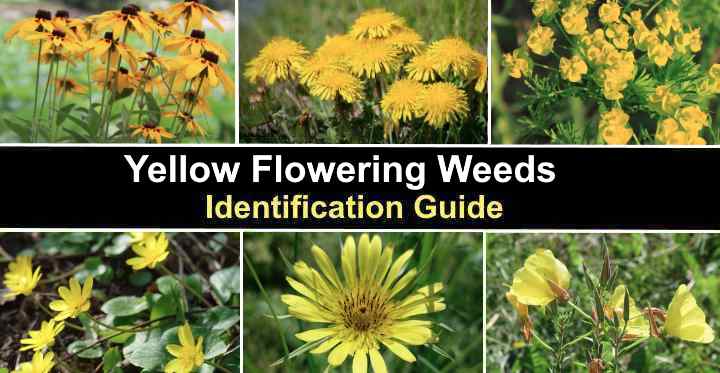
Yellow-flowering weeds are among the most common invasive plants growing in yards. The pesky plants with yellow flowers seem to pop up where you least expect or want them. The invasive yellow-flowering wild plants can invade lawns, take over flower beds, choke out cultivated plants, and give you more work weeding the front or backyard.
Many yellow-flowering weeds produce spectacular blooms in bright golden-yellow colors. Despite their beauty, many weedy plants spread rapidly due to extensive root systems, seed dispersal, and overground runners. Therefore, eradicating unwanted yellow-flowering, invasive plants from your yard can be challenging.
Knowing how to identify yellow-flowering weeds is crucial for their eradication. This article serves as an identification guide to yellow-flowering weeds, providing descriptions and pictures of common weeds with yellow flowers. It will assist you in identifying and managing these invasive plants in your garden or lawn.
What Are Yellow-Flowering Weeds?
Yellow-flowering weeds are non-cultivated plants with yellow blooms. The weeds with yellow flowers often compete with desirable plants for resources like water, nutrients, and sunlight, hindering their growth. They can be invasive and resilient and tend to thrive in diverse environments. These characteristics of weedy plants make them challenging to control.
The label “yellow-flowering weed” is usually subjective. Some stunning ornamental plants like creeping cinquefoil, yellow coneflowers, evening primrose, and golden clover are weedy. Still, they can be useful in a landscape for yellow-flowering ground cover or attracting pollinators. However, other small plants are typically recognized as weeds. These include dandelions, purslane, ragwort, and wood sorrel.
Weeds with Yellow Flowers (with Pictures): Identification Guide
Flowering weeds with yellow flowers can add a burst of color to any garden or landscape—wanted or unwanted. Many non-native plants are invasive; however, many yellow-flowering weeds benefit the ecosystem. Let’s look in detail at the most common yellow-flowering weeds you are likely to find in your front garden or backyard.
Dandelion (Taraxacum officinale)
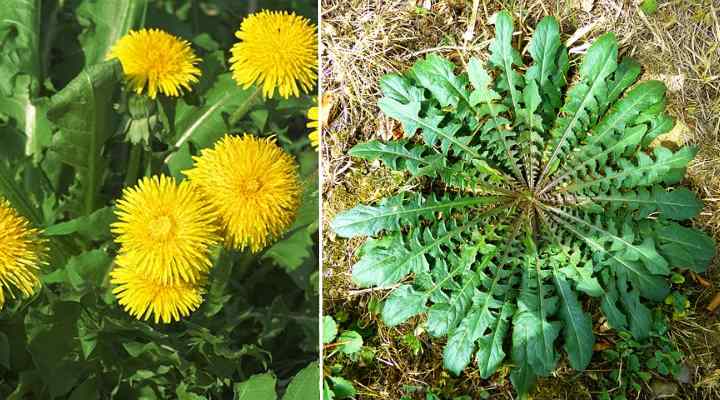
Dandelion is a common yellow-flowering lawn weed often considered a nuisance plant. The perennial weed is identified by bright yellow flowers that turn into fluffy white seed heads. The plant’s linear leaves have a distinctive tooth-like appearance. Additionally, dandelion weeds have a deep taproot, making them difficult to remove completely from lawns.
The dandelion blooming period is from early spring through late fall. The small nuisance weed’s yellow flowers grow 2” to 12” (5 – 30 cm) tall at the top of a tubular stem. This is surrounded by a rosette of deeply lobed leaves that can spread 12” (30 cm) in diameter.
Controlling dandelions is possible by regular mowing and maintaining a healthy lawn. Thick, healthy grass will compete with the weed, making it harder for dandelions to get established. Additionally, manually removing the weed by digging up the entire taproot can help prevent its spread.
Common Evening Primrose (Oenothera biennis)
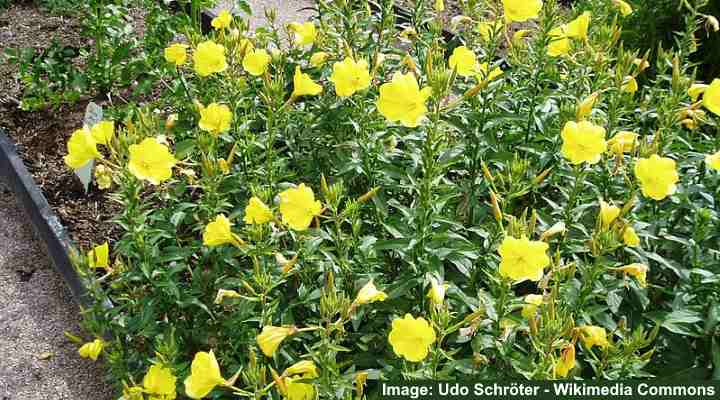
Common evening primrose is a weedy perennial plant with large bowl-shaped yellow flowers. It is identified by its purple-tinged stems, oblong green lance-shaped leaves, and bowl-shaped yellow flowers. Blooming from early summer through fall, the bushy weed can become invasive if left uncontrolled.
Common evening primrose’s weedy growth comes from its aggressive self-seeding habit, with each plant producing thousands of seeds. It can quickly take over open areas, including lawns, gardens, and roadsides.
Common evening primrose grows 3 to 5 ft. (1 – 1.5 m) tall and 3 ft. (1 m) wide. It tolerates poor soil, drought, and partial shade, making it difficult to control.
Despite the bold splash of yellow color in summer gardens, it requires hand-pulling to prevent it from overtaking a flower bed. Sometimes, herbicides can be an effective control method. Removing flowers before they seed can help control the plant’s spread.
Cypress Spurge (Euphorbia cyparissias)

Cypress spurge, also known as graveyard weed, is a perennial weed with yellow flowers. It grows up to one foot (30 cm) tall and is identified by its small bright yellow-green flowers and narrow, lance-shaped leaves. The problematic plant becomes invasive by spreading through underground rhizomes that can quickly take over an area if not controlled.
Yellow-flowering cypress spurge competes aggressively with cultivated plants and native wildflowers. It thrives in rich, moist soils and requires regular pruning, thinning, and digging to stop it from taking over a landscape. Additionally, its resilience makes it a tough weed to eliminate. It’s tolerant to drought, pests, diseases, and dry, rocky soils.
Cypress spurge thrives throughout most of North America and is commonly used as a yellow-flowering ground cover plant. If left unchecked, it can grow 1 ft. (0.3 m) tall and 2 ft. (0.6 m) wide.
Creeping Cinquefoil (Potentilla reptans)
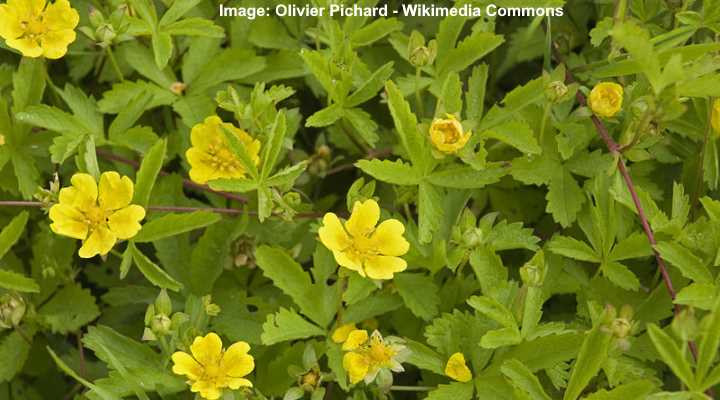
Creeping cinquefoil is a creeping perennial that can become a nuisance yellow weed in lawns and gardens. Identifying features of the creeping weed are its small yellow buttercup-like five-petalled flowers and serrated leaves growing on long stalks. Creeping cinquefoil becomes invasive when its stems root along the ground as it spreads.
Creeping cinquefoil competes with native plants and turfgrass for resources, smothering them at the root level. The spreading ground cover plant can spread over 107 sq. ft. (10 sq. m) in a single season if uncontrolled.
Preventing this weed from spreading and taking over gardens and lawns is important. Regular mowing and maintaining a healthy lawn can help prevent the weed from establishing itself.
If creeping cinquefoil has become a problem in your yard, hand-pulling or digging out the weed can be effective, albeit time-consuming. Dandelion weeding forks can help remove the deep taproots. And keeping lawns and soil fertile and well-watered can hinder its weedy growth.
Golden Clover (Trifolium aureum)
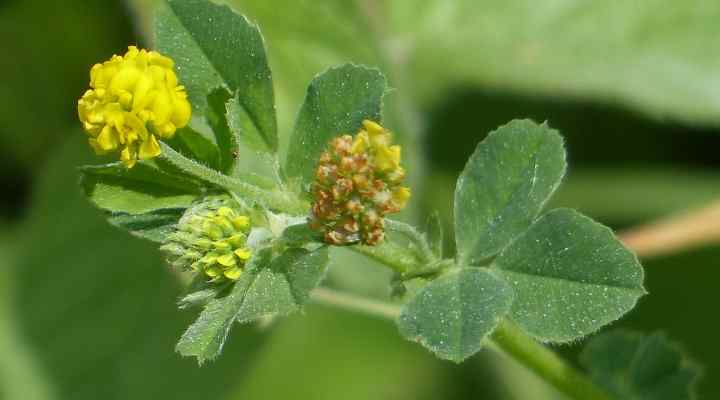
Golden clover, or large hop clover in the genus Trifolium, is an annual yellow-flowering weed. This invasive weed is characterized by its yellow hop-like flowers and trifoliate leaves. As the plant matures, the bright yellow flowers turn brown and papery.
Golden clover spreads rapidly and can quickly take over grassy areas and gardens if left unchecked. Like many non-native plants, it competes with native plants in the US for nutrients and sunlight. It can shade out other plants and choke them at the root level.
The small yellow-flowering weed doesn’t grow taller than a foot (30 cm). However, it can spread uncontrollably through seed dispersal, underground rhizomes, and when mowing infested lawns.
Black Medic (Medicago lupulina)
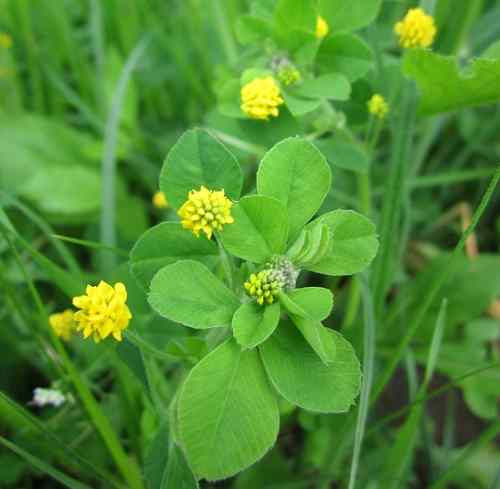
Black medic is a common yellow-flowering annual weed that invades lawns, gardens, and vegetable patches. This broadleaf weed is identified by its slender pea-like yellow flowers and trifoliate, kidney-shaped leaves growing on prostrate, spreading stems. Its rapid growth means it can quickly take over grassy areas without control.
Black medic is considered a weed because it competes with desirable grass species. The yellow weed spoils a lawn’s appearance, creating a mat of yellow flowers and an uneven and patchy look. Also, its seeds can remain dormant in the soil for several years before germinating, making weed control challenging.
Regular maintenance and lawn care can help prevent black medic from getting established in lawns. It is also difficult to differentiate the yellow weed from another common lawn weed—California burclover.
California Burclover (Medicago polymorpha)
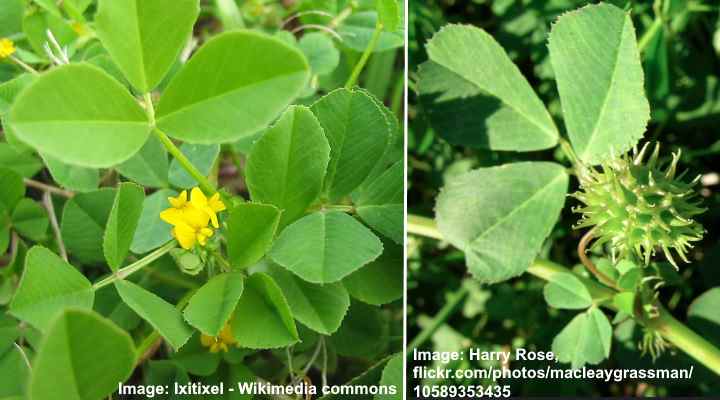
California burclover is a low-growing annual weed with yellow flowers that is common in warm climates. This weed is identified by its trifoliate leaves, small yellow flowers, and sticky burs. These prickly seeds become a nuisance when they attach to clothing and animal fur, aiding in the weed’s spread.
California burclover is a fast-growing weed that can take over lawns when uncontrolled. It spreads by its spreading stems when they root in the soil at the nodes. As a mat-forming weed, it competes with desirable plants for vital resources and disrupts ecosystems.
Yellow Sorrel (Oxalis stricta)
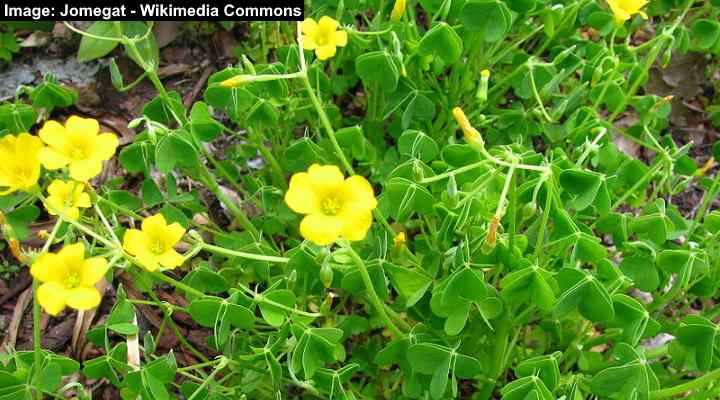
Yellow sorrel is an aggressive, low-growing perennial weed that can take over lawns and gardens. It has branching stems covered in heart-shaped leaves and dainty yellow funnel-shaped flowers with five petals. Yellow sorrel spreads quickly through its underground rhizomes, spoiling the appearance of lawns.
The aggressive growth of yellow sorrel can crowd out desirable plants and grasses. It forms colonies in grass from tough underground stems, making lawns look patchy.
Regular mowing, letting the grass grow longer, and maintaining a healthy lawn with organic fertilizers and regular watering can help prevent yellow sorrel from becoming established. For example, yellow sorrel prefers dry, sandy soils. So, keeping turfgrass fertile and constantly moist can hinder the yellow weed’s growth.
You can pull some weeds by hand to remove small infestations. However, eradication requires getting rid of the entire root system.
Yellow Nutsedge (Cyperus esculentus)
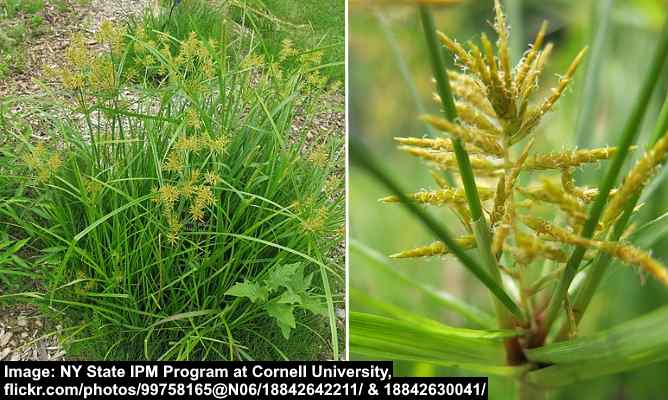
Yellow nutsedge is a persistent and invasive perennial plant that forms clumps of grassy weeds in lawns and garden beds. This yellow-flowering weed is identified by its spikes of bright golden-yellow or straw-colored flowers, slender grass-like leaves, and stems with a V-shaped cross-section. The noxious weed produces small brown seeds that remain viable in the soil for several years.
Yellow nutsedge grows 0.5 to 2 ft. (15 – 60 cm) tall. It’s a difficult weed to eliminate because it spreads through tough underground tubers that multiply rapidly to form new plants. Hand-pulling or digging out the tubers is often ineffective, as even small fragments left behind can regrow.
Garden Loosestrife (Lysimachia vulgaris)
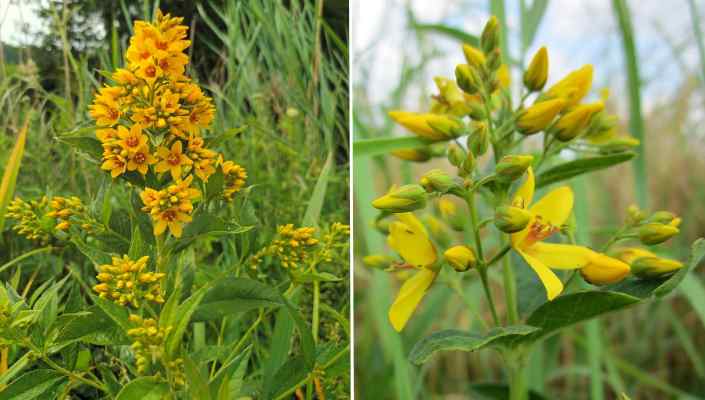
Garden loosestrife, known as Lysimachia vulgaris, is a tall perennial weed with yellow flowers. The yellow-flowering weed is characterized by its upright stems growing 5 ft. (1.5 m) tall, clusters of yellow and orange cup-shaped flowers, and ovate to lance-shaped leaves. It blooms throughout summer.
Golden loosestrife was introduced to the United States, and it competes with native plants, eventually taking over large garden areas. Also, its tall, leafy stems shade out other plants and reduce biodiversity in infested areas. The plant can also spread rapidly and be difficult to remove once established.
Bird’s Foot Trefoil (Lotus corniculatus)
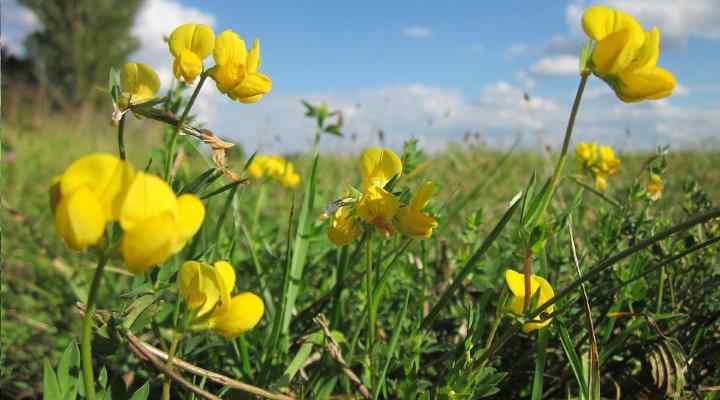
Bird’s foot trefoil is a ground-hugging lawn weed that produces yellow pea-like flowers. The weed’s yellow flowers bloom in small clusters, contrasting with the small oval clover-like leaves growing on short stems. The perennial weed is characterized by clusters of bright yellow flowers and distinctive seed pods resembling a bird’s foot.
Bird’s foot trefoil is considered an exotic yellow-flowering weed. Its spreading stems quickly root in the soil and easily form a mat of foliage and yellow flowers up to 3 ft. (1 m) wide. The weed competes with native grass species, reducing the overall quality of lawns.
Some gardeners use bird’s foot trefoil in a landscape for yellow-flowering ground cover, a low-mow lawn alternative, or border edging.
Lesser Celandine (Ficaria verna)
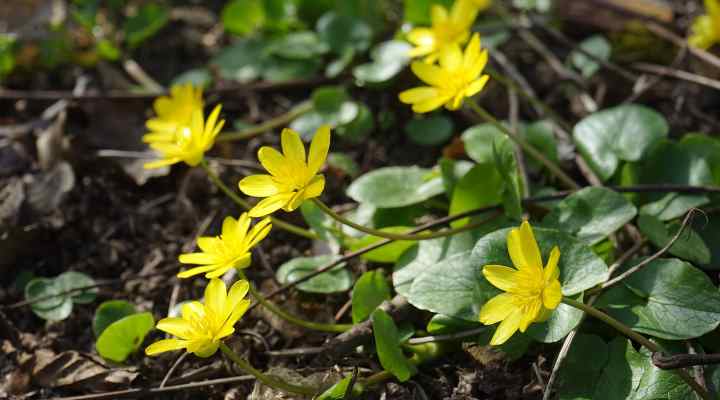
Lesser celandine, also known as Ficaria verna, is a yellow-flowering, perennial weed that quickly takes over gardens and grassy areas. This invasive weed develops foliage early in the season, sucking nutrients from native plants. It aggressively spreads, forming a thick blanket of dense leaves. Pretty star-shaped yellow flowers bloom in late winter and early spring.
Related to buttercups, lesser celandine grows 10” (25 cm) tall and wide. Its prostrate stems easily root in the soil, and it spreads through underground tubers.
Hand-pulling lesser celandine weeds and removing the tubers can be effective. But eradicating the annoying weed requires persistence.
Wild Parsnip (Pastinaca sativa)
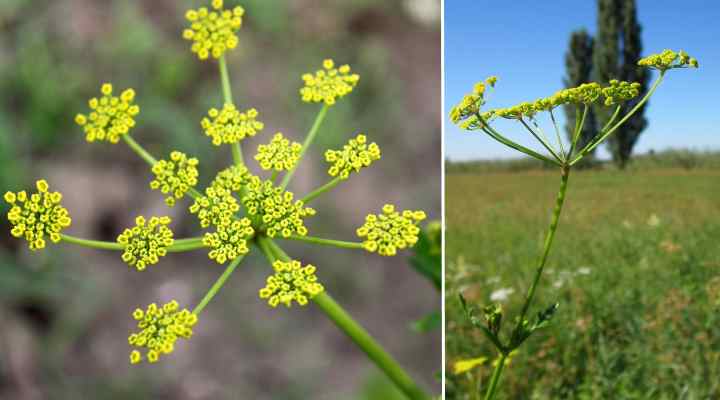
Wild parsnip is a yellow-flowering weed that can invade roadsides and uncultivated backyard areas. It is a biennial plant that is usually grown as an annual. Identifying features of the invasive plant are its umbrella-like clusters of pale yellow flowers, oblong serrated leaves, and winged seeds dispersed by the wind. This weedy plant looks and smells like cultivated parsnip.
Wild parsnip can grow up to 5 ft. (1.5 m) tall and has a strong taproot. Besides its ability to choke out surrounding vegetation and plants, the weed contains toxic chemicals. The plant’s sap can cause skin irritation and burns, especially when exposed to sunlight.
It is important to wear protective clothing and gloves when handling this weed to avoid contact with the sap. The best control methods are to dig out its large white taproot and remove flowers before they turn to seed.
Purslane (Portulaca oleracea)
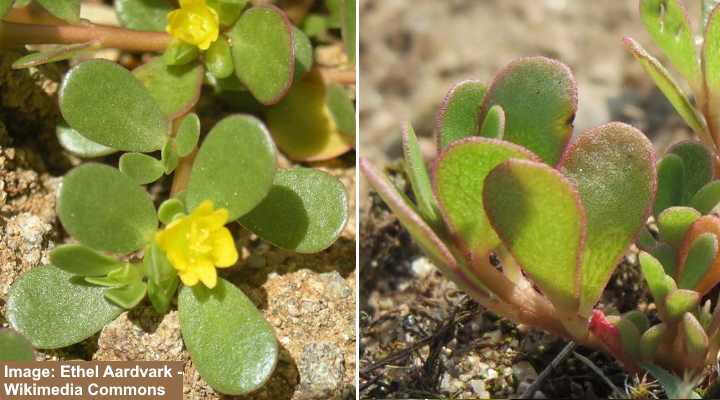
Purslane is a low-growing annual weedy plant that can take over lawns and gardens. This fast-spreading weed has small cup-shaped yellow flowers with heart-shaped petals. It features succulent paddle-shaped leaves growing on reddish stems. Purslane grows up to 3” (7.5 cm) tall and can spread up to 18” (45 cm) wide.
Despite its status as a weed, purslane has some redeeming qualities. It is good for ground cover in full sun, and its leaves are edible. However, its rapid growth, high tolerance to drought and poor soil, and ability to form thick, dense mats and choke out desirable plants give it invasive qualities.
Butterweed (Packera glabella)
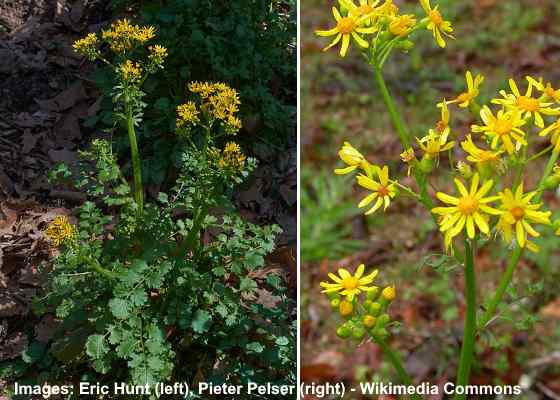
Butterweed, also known as Packera glabella, is a yellow-flowering weed that can be invasive in lawns and gardens. This annual or biennial weed is characterized by its bright yellow flowers and toothed, lobed leaves. Butterweed can quickly spread and take over open areas if not controlled properly.
The best way to prevent butterweed from becoming a problem in your yard is to maintain a healthy lawn and garden. Regular mowing and proper watering can help prevent the weed from establishing itself. Additionally, hand-pulling or spot-treating with herbicides can be effective in controlling butterweed.
Canada Goldenrod (Solidago canadensis)
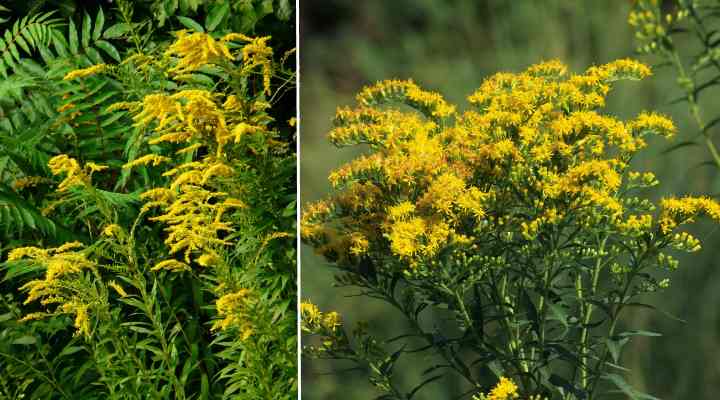
Canada goldenrod is a yellow-flowering weedy plant related to sunflowers. This native perennial weed is identified by its masses of small bright yellow flowers growing in conical, arching clusters. The tall weed has lance-shaped, sharply-toothed leaves growing on central stems that are 4 to 5 ft. (1.2 – 1.5 m) tall.
Canada goldenrod is considered an invasive species because its rapid, uncontrolled growth can easily take over gardens. It spreads via underground rhizomes and can produce thousands of seeds per plant. These are easily dispersed on the wind in the fall. When they germinate and take root, the weedy plant produces messy mounds of green foliage and cascading flowers.
Wild Radish (Raphanus raphanistrum)
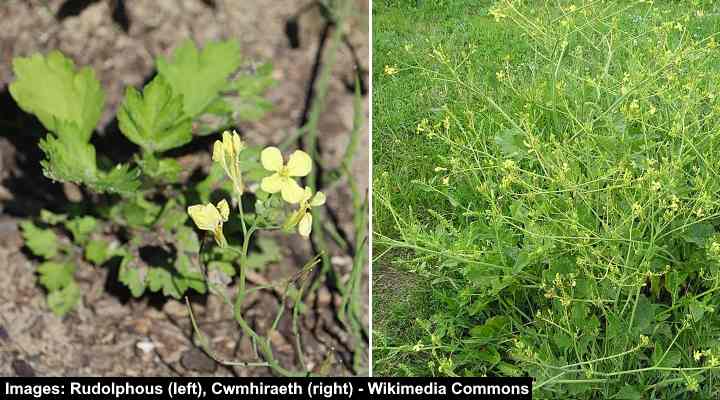
Wild radish is a yellow-flowering annual weed with elongated egg-shaped, deeply-lobed leaves. Wild radish flowers are pale yellow with four petals and have a characteristic veining pattern. The weedy, non-cultivated plant spreads rapidly through seed dispersal and has a rounded, bushy habit.
Wild radish grows 30” (75 cm) tall and can become a nuisance in gardens, vegetable plots, and agricultural fields. It’s also a competitive weed that can outcompete native plants for nutrients and sunlight. It can also produce a large number of seeds, which can remain dormant in the soil for several years before germinating.
Yellow Rocket (Barbarea vulgaris)
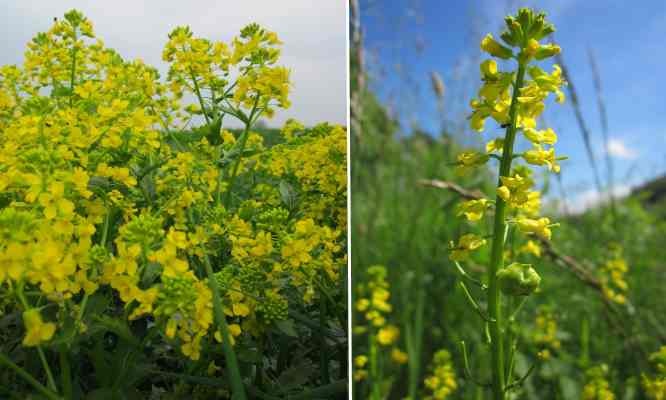
Yellow rocket is an annual or biennial yellow-flowering plant with weedy growth. The edible weed is identified by its branched clusters of bright yellow flowers, large lobed leaves with wavy margins, and slender green pods. This yellow weed can become a problem in turfgrass, forming small patches of foliage and tall flowering stems.
A member of the mustard family and early bloomer, yellow rocket grows up to 3 ft. (1 m) tall. The pest plant has a taproot and fibrous root system. However, it spreads by seed once the flowers mature. Despite its weedy growth, yellow rocket attracts pollinators to gardens and adds a splash of bright color.
Regular mowing and maintaining a healthy lawn can help prevent yellow rocket growth. It’s best to let grass grow 3” to 4” (7.5 – 10 cm) tall to prevent the seeds from germinating and stop the weed from growing.
Common Groundsel (Senecio vulgaris)
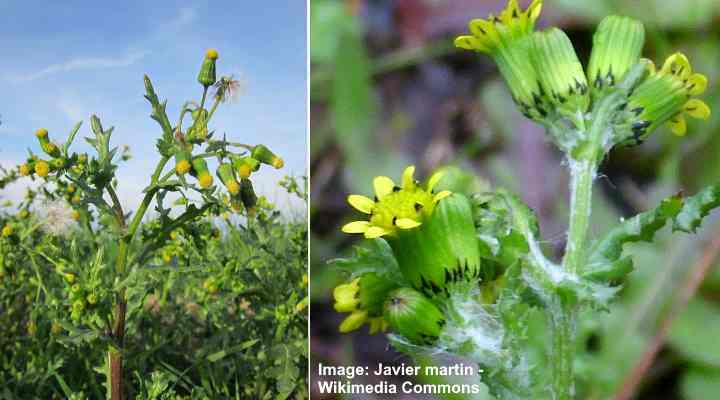
Common groundsel, also known as Senecio vulgaris, is a nuisance plant with open clusters of cylinder-like yellow flowers. This annual herbaceous weed is identified by its long, lobed leaves growing on erect stems. These are topped by small yellow flowers that are surrounded by leafy black tipped bracts at the base.
Groundsel grows 1.3 to 2 ft. (0.4 – 0.6 m) tall. When the flowers mature, they develop white puffballs like dandelion leaves. These light, fuzzy seeds easily spread large distances in light breezes. The weed can quickly establish itself and outcompete desired plants for resources like sunlight and nutrients.
Despite being native to North America, common groundsel is listed as a noxious weed toxic to livestock and humans.
Spanish Broom (Spartium junceum)
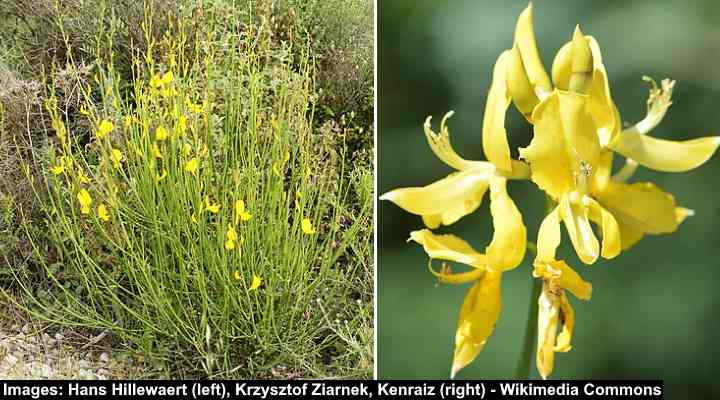
Spanish broom is a yellow-flowering perennial shrub that can quickly grow out of control. This weed is identified by long, slender green stems growing 10 to 16 ft. (3 – 5 m) tall. The bright yellow flowers have irregularly shaped petals that are 1” (2.5 cm) long and bloom at the ends of stalks in summer and fall.
The problem with Spanish broom is that the yellow weed spreads rapidly, crowding out native plants and disrupting ecosystems. It easily regenerates and spreads by seed. Therefore, removing the seed pods and digging out the root can help prevent its spread.
Yellow Salsify (Tragopogon dubius)
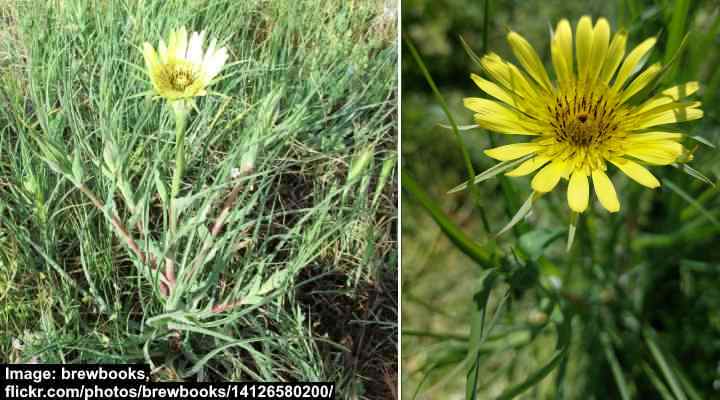
Yellow salsify, known as western salsify or goat’s beard, produces eye-catching yellow flowers resembling dandelions. Commonly found in grassy areas along the coast, the weed can spoil the appearance of lawns. It has linear, lanceolate leaves with stems that produce a milky latex.
Typically biennial plants, yellow salsify can quickly take over an area if not controlled. It competes with native plants for resources, crowding out desirable grass and flowers. The deep taproot of the weed makes it difficult to remove completely.
Like dandelion flowers, the disk, star-like yellow flowers turn to fluffy white seed heads. These disperse easily in the wind. Therefore, the best control method to eliminate yellow salsify is to remove the entire taproot before the plant goes to seed.
St John’s Wort (Hypericum perforatum)

St John’s Wort is a perennial weed with yellow flowers that can be invasive and difficult to control. Described as a noxious weed, the yellow-flowering plant is covered in golden-yellow star-like five-petalled blooms up to 0.78” (2 cm) across. Its leaves are typically linear or elongated oval and feature translucent glands.
This perennial plant has all the characteristics of an annoying weed. It thrives in most environments, spreads rapidly, has a trough root system, and forms dense mats that outcompete native plants, impacting biodiversity. St John’s Wort spreads through seeds and its tough root system.
Creeping Buttercup (Ranunculus repens)
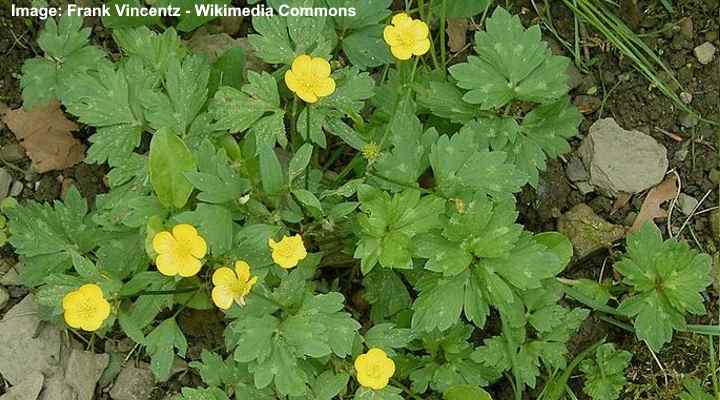
Creeping buttercup is a perennial lawn weed with clusters of bright yellow five-petalled flowers that bloom from spring to summer. This invasive weed is identified by its creeping stems that root at the nodes, and glossy dark green leaves resembling parsley.
Low-growing creeping buttercup grows 20” (50 cm) tall and spreads aggressively up to 40 sq. ft. (3.7 sqm) a year. The yellow-flowering weed depletes lawns of potassium and crowds out plants in flower beds. It spreads through seeds and creeping stems that easily root in the soil. The creeping lawn weed thrives in poorly-drained soil and well-watered lawns.
Promoting good lawn health is vital to prevent creeping buttercups from spreading in your yard. This involves proper watering and fertilization. Also, improving drainage can help reduce its spread. Hand-pulling from fall to spring can be effective; however, ensure you remove the entire root system to prevent regrowth.
Common Sowthistle (Sonchus oleraceus)

Common Sowthistle is a tall, annual flowering weed with small, brightly colored yellow flowers resembling small dandelions. The upright weed can rapidly grow 3 to 4 ft. (1 – 1.2 m) tall in warm weather. Identifying features of the weedy plant are its bright yellow starry flowers, deeply lobed leaves, and tolerance for most soil conditions.
Also called milk thistle and hare’s colwort, the winter and summer weed competes with desirable plants for vital nutrients. Left uncontrolled, it can quickly colonize flower beds, lawns, and other garden areas. It easily reseeds by its numerous fluffy seeds dispersed by the wind.
Like most yellow weeds, regular mowing and maintaining a healthy lawn and soil can help prevent its establishment. Hand-pulling or digging out the weed, including its taproot, can also be effective. Applying mulch to bare ground can help prevent the weed from germinating.
Perennial Sow Thistle (Sonchus arvensis)

Also called field milk thistle, this common yellow-flowering weed is easy to mistake for dandelions in lawns. This invasive perennial weed is identified by its bright yellow daisy-like flowers, prickly leaves 4” to 12” (10 – 30 cm) long, and hollow stems containing milky sap. It can grow up to 5 ft. (1.5 m) tall and spread rapidly if uncontrolled.
Sow thistle is a prolific seed producer, with each plant capable of producing thousands of fluffy seeds. The noxious weed also spreads aggressively through its extensive root system. It regrows vigorously from tiny root fragments left in the soil.
Regular mowing and cutting remove the flowers and prevent the seeds from spreading. However, digging out the entire root system is vital for small infestations. For larger areas, herbicides may be necessary, but they should be used cautiously to avoid harming cultivated plants.
Yellow Toadflax (Linaria Vulgaris)
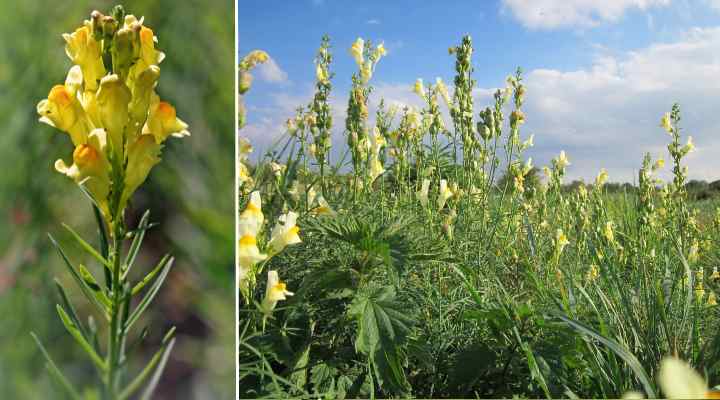
Yellow toadflax is a yellow-flowering weed with pale yellow and orange flowers that resemble snapdragon blooms. The invasive perennial weed grows quickly, choking other plants as it spreads. It’s characterized by its tall, slender stems, narrow leaves, and clusters of yellow flowers growing on tall spikes. Yellow toadflax can grow up to 2 ft. (0.6 m) tall.
Controlling yellow toadflax is important because it can outcompete native plants and disrupt ecosystems. Hand-pulling is the most effective way to eradicate seedlings. However, its creeping root system makes eliminating established weeds from lawns challenging. Mowing can help prevent the flowers from seeding. Unfortunately, only herbicides are usually effective in killing the root system.
Marsh Yellowcress (Rorippa palustris)

Marsh yellowcress is a yellow-flowering weed that thrives in moist and rich soil. Identifying features of the yellow weed are its dense clusters of small, yellow flowers and its deeply lobed leaves growing in a rosette.
The weed is an annual or biennial, or sometimes a short-lived perennial. It grows around 3 feet (1 m) tall and has a fibrous shallow root system, which makes it easier to manage.
Skeletonweed (Chondrilla juncea)
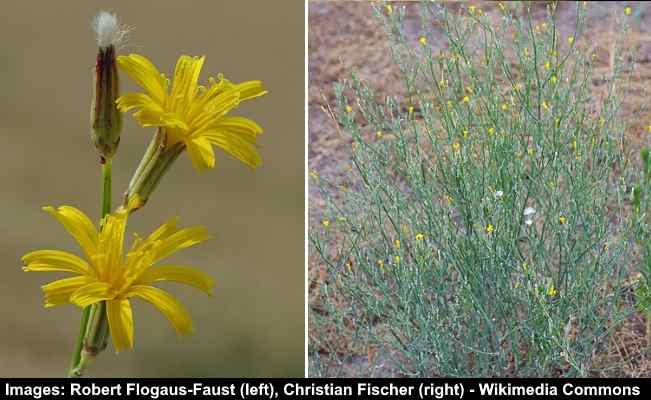
Skeletonweed is a fast-spreading biennial or perennial weed that forms thickets of wiry stems and dandelion-like yellow flowers. The weedy plant grows up to 3 ft. (1 m) tall and invades fields, pastures, and disturbed areas. This invasive weed competes for water with crops, impacting harvests.
Skeletonweed gets its name from its unique appearance—tall, slender stems that appear skeleton-like because they have tiny, inconspicuous leaves. It spreads by seed when the yellow flowers develop pappus—a fluffy seed-head like dandelion seeds.
Ragwort (Jacobaea vulgaris)
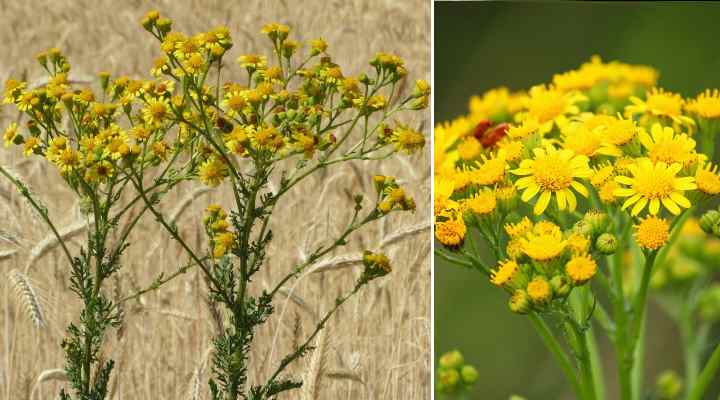
Ragwort is a toxic yellow-flowering weed with eye-catching daisy-like flowers. The blooms have orange-yellow centers, with up to 13 florets forming a disk flower. The biennial or short-lived perennial weed has wavy, lobed leaves that grow from a basal rosette before tall 6 ft. (1.8 m) stems shoot up. When blooming, masses of yellow flowers cover the weed.
Ragwort commonly invades pastures, meadows, and along roadsides. The weed spreads aggressively by seed, with a single plant producing over 150,000 seeds in a season.
Grass-Leaved Goldenrod (Euthamia graminifolia)
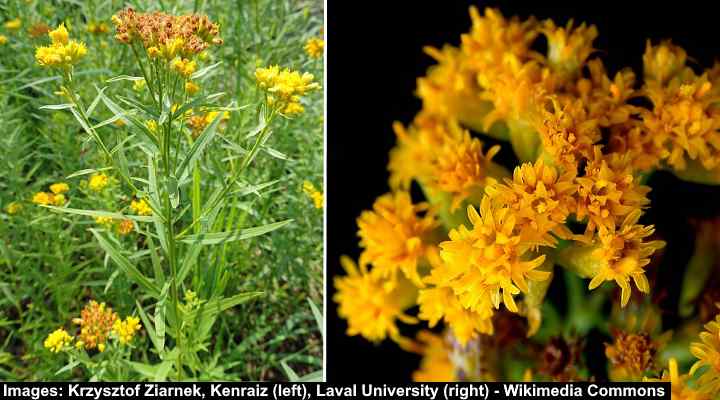
Grass-leaved goldenrod is a native wildflower with dense clusters of tiny yellow flowers. Native to North America, the yellow-flowering plant features flat-topped yellow flower clusters and tall branched stems with narrow, grass-like leaves. The perennial weedy plant grows 3 to 6 ft. (1 – 1.8 m) tall and blooms in late summer and fall.
Grass-leaved goldenrod can be beneficial for attracting pollinators like bees, butterflies, and other insects. Goldenrod’s weedy habit comes from its vigorous rhizomatous roots that spread aggressively to form colonies. However, if controlled well, you can use the yellow-flowering plant in butterfly gardens and coastal gardens and to plant along a fence line.
Yellow Hawkweed (Hieracium caespitosum)
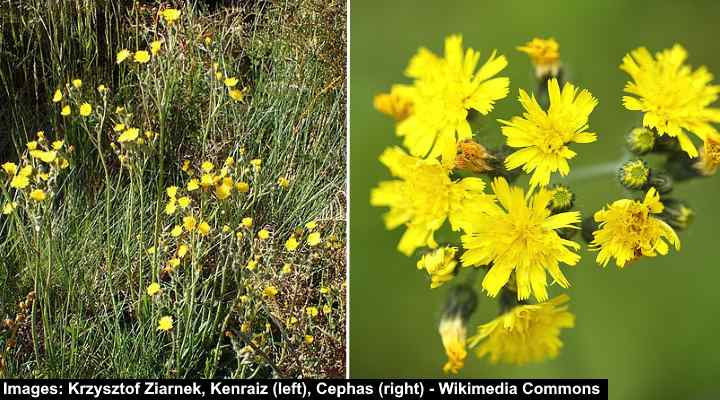
Yellow hawkweed is a perennial weed with daily-like yellow flowers. The identifying features of the weedy plant are its starry flowers growing on long, tubular stems and lobed leaves growing in a basal rosette. The yellow weed grows 1 ft. (0.3 m) tall.
Yellow hawkweed spreads via creeping roots and seeds, forming dense patches and suppressing desirable grass species. Controlling yellow hawkweed can be challenging as it has a deep taproot and can regrow from small root fragments. Digging up the weeds in spring can help eradicate the plant. However, mowing lawns tends to promote flowering.
Capeweed (Arctotheca calendula)
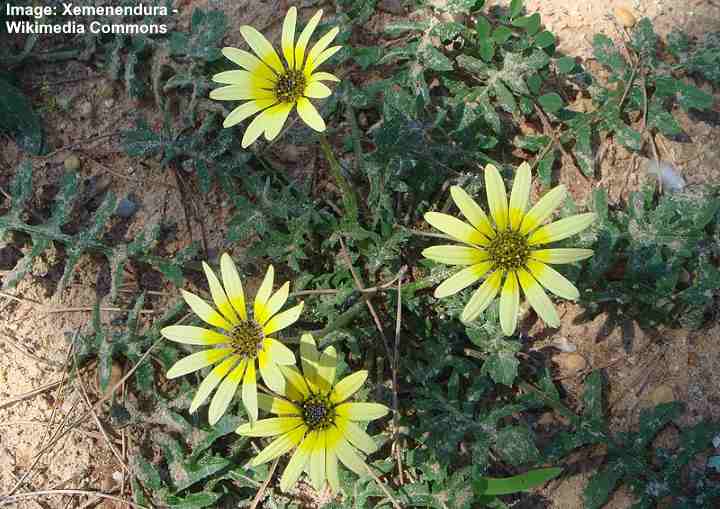
Capeweed is an evergreen perennial plant with eye-catching ray flowers consisting of yellow petals surrounding a black center. The yellow daisy-like flowers grow on hairy stalks emerging from a basal rosette of silvery-green leaves. The leaves are elongated with deeply lobed margins—typical of many yellow-flowering weeds. It’s a small yellow weed growing 12” (30 cm) tall.
This invasive weed can be problematic because it spreads rapidly through its seeds. Although its runners and rapid growth are ideal for ground cover in warm climates, it easily escapes gardens. It can shade out and choke native plants. Its deep taproot makes it difficult to remove completely.
You can control capeweed in lawns by regular mowing and maintaining healthy turfgrass. Thick, healthy grass makes it harder for capeweed to get established. In other areas, you can cover the spreading yellow weed with a weed mat or cardboard to block sunlight and kill the weed.
Yellow Sweetclover (Melilotus officinalis)
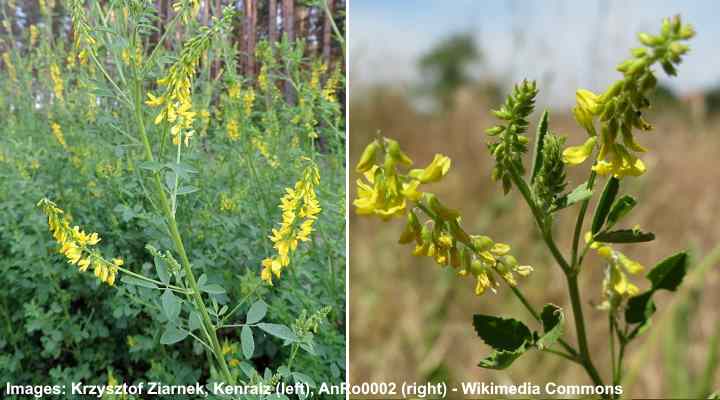
Yellow sweetclover is a tall, yellow-flowering annual or biennial weed that mainly invades pasture areas, open fields, and neglected gardens. This invasive weed is known for its bright yellow flowering spikes. The tall yellow weed has pea-like flowers growing in clusters on upright stems, and small pods containing oval seeds. The tall stems with their clusters of three leaves grow 4 to 6 ft. (1.2 – 1.8 m) tall.
Due to its invasive nature and fast growth, yellow sweetclover is considered a weed. The plant’s seeds can lay dormant for many years before germinating. This causes the plant to grow where it’s not wanted—typical of all lawn weeds. The best way to get rid of this weed is to pull it up by hand and destroy it.
Yellow Lantana (Lantana camara)
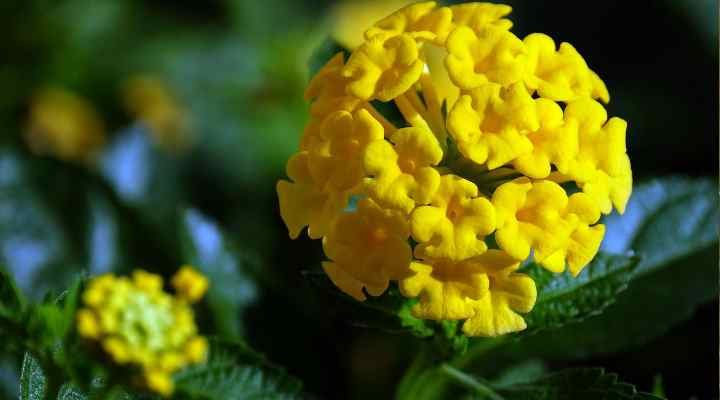
Yellow lantana—botanical name: Lantana camara—is a small flowering evergreen shrub with attractive clusters of yellow flowers. In some southern areas of North America, the heat-loving plant has become invasive and weedy. Yellow lantana is identified by its tubular-shaped yellow flowers growing in small, rounded clusters.
Control is necessary for yellow lantana weeds because they choke other plants. The weedy plant produces toxins that hinder other plants’ growth. Also, the shrubby weed has robust perennial roots that make removal challenging. It’s considered a noxious weed in Florida, Texas, and Hawaii.
In gardens, lantana shrubs can be beneficial ornamental plants due to their colorful blooms, evergreen foliage, and low height. However, before planting lantana, check local state guidelines on its invasiveness.
Cutleaf Coneflower (Rudbeckia laciniata)

Cutleaf coneflower is a native wildflower with attractive yellow flowers blooming on slender stems. This perennial plant can become weedy because it has vigorous underground rhizomes that can quickly take over flower beds. The attractive yellow weed is identified by its yellow daisy-like flowers, drooping petals, and deeply lobed, cut-leaf foliage.
Cutleaf coneflowers can grow 3 to 9 ft. (1 – 2.7 m) tall and are popular for attracting pollinators like bees and butterflies. However, keeping them under control is vital by regularly dividing clumps and deadheading old flowers. Because of their aggressively spreading nature, they are only suitable for large landscapes.
Suppose you want to plant native tall plants with yellow flowers in a garden landscape. In that case, tall flowering perennials like black-eyed Susans or yellow coneflowers (Rudbeckia hirta) are a better option. They don’t spread as aggressively as cutleaf coneflowers and provide height and a splash of color at the back of borders or cottage gardens.
Related articles:
- Homemade Weed Killers: Natural, Safe, Non-Toxic
- Pink Flowering Weeds: Identification and Control
- Creeping Lawn Weeds: Identification and Control
